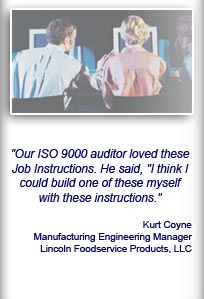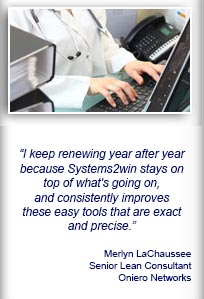Installation and Setup
Installation - Each User. Installation - Multi-user. Language Translations. Personalize Your Templates.Systems2win Training.
Quick Start Initial Training. New User Training. Training Matrix. Systems2win Leadership. Training Classes.Lean Training
Lean Training and Coaching. Lean Principles. Muda 8 Wastes. Goal - Lean Flow. Roadmap - Lean Journey. Value Stream Mapping. Standard Work. Hansei Lean Thinking. Lean Dictionary. Online Lean Training. Lean Leadership.Microsoft Office Training
Excel Training. Excel Drawings (without Visio). Excel Charts. Word Training. PDF Training. Document Storage and Naming.Support
Support.Process Improvement
Questions and Answers
There are many tools and techniques in business and process improvement, and while many of the teachings are similar, there are important differences. It might be difficult to identify upfront whether it’s best to use Lean methods or Six Sigma methods. Here are some of the most common questions that you need answers to.
Which is the best Process Improvement approach: Lean or Six Sigma?
Worldwide there are a bewildering number of certification programs to train people to become Green Belts, Black Belts, or even the highest level of Master Black Belt.
If you look up the impartial case studies on the internet, you will find that the classic statistics-intensive approach to Six Sigma quality improvement is not for the wishy-washy. Companies who have published their successes have done so after many years of relentless commitment. You will also be hard-pressed to find many small companies that can afford the discipline and costly training that is required to effectively implement Six Sigma programs.
But, does that mean there's no merit for a small or medium-sized company to define, measure, analyze, improve and control its processes? Absolutely not! You just need to be a little less zealous about measuring and statistically analyzing every little thing, and instead, employ some entrepreneurial common sense to utilize those 20% of best practices that can yield 80% of the benefits to you.
Here's what most studies have found:
Lean and Kaizen techniques for process improvement, when employed all by themselves, yield some rapid early benefits and then tend to bog down in a mess of little further progress. Primarily, because they are too prone to the "cowboy shoot from the hip" mistakes of thinking that everyone knows what the problem is and then running out to solve that problem, and then finding out that it really wasn't the root problem after all.
And the Six Sigma methods of DMAIC and DFSS for process improvement, when employed all by itself, takes years of expensive investment before beginning to show measurable results.
So, the big news published by these well-documented comparative case studies is that the big winners are the companies that implement both Lean and Six Sigma. They can commonly achieve measurable results 10 times more successful than the companies that implemented just one or the other approach for process improvement.
Free Access to Systems2win Tools
6S Scorecard, 5S Assessment, Ishikawa Diagram, Kaizen Events, Kanban Calculator, FMEA, Standard Work, OEE, Job Instructions, Value Stream Map and much more. Join our mailing list...
Get over 30 Process Improvement Templates - Free for 30 Days
What are the basic steps to take when implementing Business Process Improvement?
If you are just getting started with continuous improvement, then you start with Lean, and specifically Kaizen methods:
- To get your people involved in process improvement;
- And to tap into your group knowledge to quickly identify your low hanging fruit;
- And quickly get rid of some obvious waste.
Once you have gained your team's support for implementing improvement initiatives and people are communicating better with each other, then use the Standard Work tools to thoroughly document each process and ensure that people really are doing things the way that everyone agreed to.
After you've established the habit of religiously documenting and auditing your standard work, the next step is to begin reducing your inventories. This is when quality problems start emerging that have been hidden beneath all those protective layers of inventory.
This is when you will begin noticing the many benefits of Six Sigma, which you might be able to achieve with the use of a few simple statistics and non-statistical tools. It is important to note that not every process is important enough to deserve the investment of time and money to achieve the standard of excellence of Six Sigma. But these same tools and methods can be used to improve any process to a level of quality that is cost-effective and appropriate.
That is what the Systems2win DMAIC Six Sigma templates are designed for. An entire suite of Excel templates, all professionally developed and ready to just fill in the blanks with your data. The added bonus is that they all come with online training, containing summary notes from all those expensive Six Sigma statistical books, instantly available and free when you need to be reminded of what you should be reading about, right at the moment that you're going to actually use your new power tool.
Systems2win makes it easy to progress along the lean journey, by empowering leaders with the tools they need, right at the beginning, to continuously improve. The Systems2win templates are designed to fill in the holes in your quality toolkit, doing an excellent job of supplementing statistical software, once you are ready to progress to the higher levels of Six Sigma.
Lean Systems and Standardized Metholodologies
Join our mailing list to get helpful resources and information about how to implement standardized systems for continuous process improvement.
Ask us a question
Tell us what question you need answered and we will email you with feedback. Systems2win is here to offer guidance and advice.
Please be patient while the form loads below:
Download Trial Now
Get a dozen trial templates,
and another dozen free gifts
@@@ Better conversion rate
if call to action is for a specific tool, and shows the image

Try It
Try this template
along with a couple dozen more
process improvement tools
Calls to Action Botttom
Related Topics
Related Topics section WITHOUT TESTIMONIALS
Replace this paragraph with menu library item for topics related to this video
Training and Coaching
Consider Training and Coaching to support your teams to succeed

Training to get you started.
Tools you won't outgrow.
Schedule a Conference
Schedule a conference
to discuss your challenges
with an experienced lean advisor



























